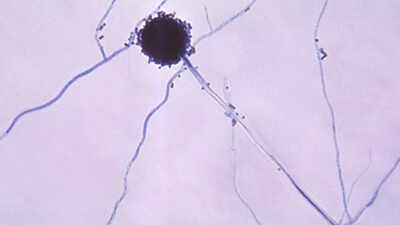Global pandemic warning: Aspergillus deadly fungus mirrors HBO’s ‘The Last of Us’ |

As climate change accelerates, it is not only reshaping our weather patterns and ecosystems but also silently altering the spread of dangerous pathogens. Among these, Aspergillus—a common yet potentially deadly fungus—is gaining new ground. Once confined primarily to warmer regions, this airborne threat is now forecasted to expand its reach into parts of North America, Europe, China, and Russia. A recent study by researchers at the University of Manchester employed advanced climate modeling to predict how Aspergillus will migrate in response to rising temperatures, warning that millions more people may be at risk of infection by 2100.While Aspergillus is a familiar organism to scientists and farmers, its ability to cause invasive aspergillosis—a severe lung infection—makes it a serious public health concern. The new findings arrive amid a global rise in fungal infections, which already claim an estimated 2.5 million lives annually. These numbers may be underreported due to the difficulty in diagnosis and the limited global surveillance of fungal diseases. This article explores the science behind Aspergillus, the impact of climate change on its distribution, and the urgent need for enhanced monitoring and medical preparedness.
What is Aspergillus? Understanding the fungus among us
Aspergillus is a genus of over 300 mold species that thrive in various environments—soil, plant matter, decaying leaves, compost, and even indoor dust. Although many species are harmless and some are even useful in industrial fermentation (like soy sauce or citric acid production), several are pathogenic to humans and animals.Among the most concerning are:
- Aspergillus fumigatus: The most common cause of aspergillosis, particularly dangerous for immunocompromised individuals.
- Aspergillus flavus: Known for producing aflatoxins, potent carcinogens that contaminate crops like maize and peanuts.
- Aspergillus niger: Common in indoor environments and capable of causing ear infections and respiratory issues.
These fungi reproduce by releasing microscopic spores (conidia) into the air. While healthy individuals can inhale these spores with little consequence, vulnerable populations—including those with asthma, COPD, cancer, organ transplants, or HIV—face a much higher risk of serious complications.
Aspergillosis explained: The deadly lung infection you’ve probably never heard of
Aspergillosis refers to a group of diseases caused by Aspergillus spores that take root in the lungs and sometimes spread to other parts of the body. The most severe form, invasive aspergillosis, can be fatal if not treated promptly.Types of Aspergillosis:
- Allergic bronchopulmonary aspergillosis (ABPA): A hypersensitive reaction often seen in asthma or cystic fibrosis patients.
- Chronic pulmonary aspergillosis (CPA): Long-term infection leading to lung cavities and respiratory decline.
- Invasive aspergillosis: A fast-spreading, often deadly condition in immunocompromised individuals.
Symptoms include:
- Persistent cough
- Shortness of breath
- Fever
- Chest pain
- Hemoptysis (coughing up blood)
What makes aspergillosis particularly dangerous is the difficulty in diagnosis. Its symptoms often mimic other respiratory illnesses, delaying appropriate treatment. Moreover, treatment options are limited, with only four primary classes of antifungal drugs available—azole resistance among Aspergillus species is growing, making infections harder to treat.
How climate change is driving the spread of Aspergillus
The University of Manchester study underscores a chilling reality: as global temperatures climb, so does the habitat range of heat-tolerant fungi. Using a combination of climate simulation models and fungal biology data, researchers evaluated how Aspergillus species will respond to two climate scenarios—moderate emissions and high fossil fuel use.Key findings:
- Aspergillus flavus, a heat-loving fungus, is projected to expand its global range by 16% under high-emission scenarios.
- Aspergillus fumigatus, traditionally found in temperate regions, may shift its range northward, with a 77.5% increase in its potential habitat by 2100.
- This expansion could put 9 million more people in Europe at increased risk.
- Cooler regions such as northern China, Russia, and parts of Canada could soon become hotspots for fungal colonization.
- Conversely, sub-Saharan Africa, already experiencing extreme temperatures, might become too hot for certain Aspergillus strains, leading to unexpected shifts in ecological balance.
Why heat makes fungi stronger
Fungi generally struggle to thrive at the high internal temperatures of mammals. However, as average global temperatures rise, fungi are slowly adapting to heat stress. This means they are more likely to survive—and flourish—inside the human body. This heat-hardening process could lead to the emergence of new, more virulent fungal strains capable of overcoming our natural defenses.In addition to temperature changes, climate-linked weather events like hurricanes, tornadoes, and floods play a critical role in dispersing fungal spores. The 2011 tornado in Joplin, Missouri, for example, led to a rare and deadly fungal outbreak. As these extreme weather events become more frequent, the spread of Aspergillus spores across long distances will likely increase, enhancing their potential to infect new populations.
Public health implications: Who is at risk?
Populations most vulnerable to the threat of Aspergillus expansion include:
- Immunocompromised individuals (e.g., cancer, HIV, or transplant patients)
- Elderly populations
- People with respiratory conditions such as asthma, cystic fibrosis, or COPD
- Rural populations with increased exposure to airborne spores from agriculture
In regions projected to become new habitats for Aspergillus, public health systems may not be adequately prepared to diagnose or treat fungal diseases. There’s an urgent need for greater awareness, improved diagnostic tools, and antifungal research funding to meet this looming threat.
Medical challenges: Drug resistance and diagnostic gaps
One of the most alarming aspects of the fungal threat is growing antifungal resistance. Azoles, the most commonly used antifungal drugs, are becoming less effective due to overuse in both medicine and agriculture. Some Aspergillus strains now exhibit multi-drug resistance, rendering current treatments ineffective and complicating recovery.Further compounding the crisis is the lack of rapid diagnostic tests. In many healthcare settings, fungal infections are misdiagnosed or only detected at advanced stages. Unlike bacteria or viruses, fungal pathogens are harder to culture and require specialized labs to identify accurately.
















